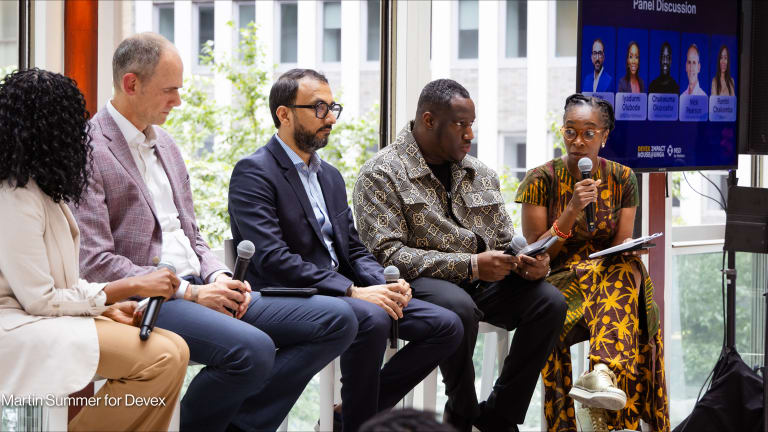
Amid the pandemic, calls have been made to bolster WASH facilities in places such as schools and health care facilities after deficits were made glaringly obvious by COVID-19.
One in four health care centers around the world have no hand-washing facilities, and in the lowest-income countries, almost half have no clean water.
“Especially in the health systems strengthening sector, [WASH is] often an afterthought even though it’s like the ground floor of everything,” explained John Sauer, senior technical adviser on WASH at Population Services International.
That deficit means that over 1 million deaths can be linked to unclean births each year, while out of 10 out of 100 hospitalized patients in low- and middle-income countries will acquire a health care-associated infection. Untreated wastewater and fecal sludge from health care facilities — which can contain antibiotics as well as resistant pathogens and genes — also increase the potential for antimicrobial resistance.
To remedy this, in 2019, health ministers signed a resolution on water, sanitation, and hygiene in health care facilities, committing to the development of national road maps, setting targets, increasing investments, and strengthening systems. In 2018, United Nations Secretary-General António Guterres also made a global call to action for achieving WASH in all health care facilities.
While much of this work relies on funding that’s often in very short supply — fewer than 14% of countries have the resources needed to implement WASH plans — and progress can be slow, Devex asked experts what first steps new and existing health care facilities can take to improve their access to WASH and ultimately save more lives.
1. Build maintenance capabilities
“Usually when [health facilities] don’t have the basic WASH services it’s because they may have had a water system in place but that has broken down,” said Zoe Pacciani, director of operations at the Freshwater Project International, adding that the first thing to do is diagnose the source of the problem.
While someone might then be able to repair them, Pacciani said that a lack of local maintenance could mean it continues to be a challenge.
Paul Avery, a civil engineering specialist at Build Health International — an organization that has helped to build health infrastructure in hospitals in places such as Haiti, Liberia, and Niger — said a lack of maintenance staff prevented the team from rolling out a sanitation system in the Maternal Center of Excellence at Sierra Leone’s Koidu Government Hospital.
“Through a series of tanks, vessels, chambers, and whatnot [the wastewater system] treats the wastewater to a point that it’s okay to discharge it to the surface, but we can’t do that there because there’s nobody who can operate and maintain it,” he said.
A lack of budget and the absence of an institution that takes responsibility for maintenance from a financial perspective is a problem in many places, Pacciani said. In Uganda, 3% of the national budget goes toward water and environment — an area that is not budgeted for in health care facilities.
Civil society protests water's emergence on the stock exchange
The introduction of the world’s first water futures market has civil society organizations worried about the threat it poses to water as a human right.
At the national level, WASH in health care as a specified budget line should be advocated for, Pacciani said. “If this is done, there’ll be no ambiguity about how those funds are intended to be spent and, as a result, funding will be available for the installation, improvement, and maintenance.” On a local level, she said charging a small fee at a health care facility, either for water collection or health care services, could provide funds for maintenance.
The development of the local private sector could also help, Sauer suggested. “In a lot of areas there isn’t a janitorial service to be able to subcontract to a health care facility to do ongoing cleaning, operations, and maintenance so if private sector entities were developed more, then you could have those kinds of services,” he said.
2. Use WASH FIT
Prakash Bohara is a health and WASH program coordinator at international humanitarian federation Terre des Hommes, or Tdh, which has supported Nepal’s Ministry of Health and Population in restoring 11 primary health care facilities following the 2015 earthquake.
In an email, he called the Water and Sanitation for Health Facility Improvement Tool, or WASH FIT, a useful guide when the complete rebuild of a facility is not possible. “This participatory assessment tool systematically helps to identify and address the needs within the limited resources,” he said.
It then recommends a number of tasks including assembling a WASH FIT team, conducting a facility, hazard, and risk assessments; developing an improvement plan; and monitoring its progress.
In Nepal, Bohara said that Tdh created a “health facility users committee” and organized orientation sessions with other municipality stakeholders to come up with solutions to the main challenge they faced: Water scarcity.
“Further, Tdh installed a rainwater harvesting system in seven health care facilities to deal with the water scarcity issues. Health care facilities now are using rainwater — stored in the reservoir tank — for cleaning purposes to make the best use of piped water connected with the community,” he said.
In many cases, Bohara said they also focused constructing a reservoir water tank so that there’s always seven days’ worth of water supply in case of disaster while providing sanitation facilities that were child-, gender-, and disability-friendly, as well as water tanks, hot and cold water, placenta pits, and hand-wash basins.
3. Look at waste streams
If a health care facility’s wastewater has the potential to be contaminated with infectious diseases — perhaps coming from an infectious disease clinic — it needs to be handled carefully, Avery said. “The advice to health care facilities would be to look at what your streams are and if you’ve got things that are medical waste then [you] need to probably separate those from your regular sanitary waste during the design process because it can require a different level of treatment,” he said, adding that this could mean treating it with chlorine.
If this hasn’t been thought about upfront, it’s not too late to separate things, Avery added.
The high cost of water corruption — and how to stop it
"There’s corruption in just about every sector. But if you don’t have access to safe drinking water, people die."
According to a report by a joint WASH program of the World Health Organization and UNICEF, in 2016, in 30 out of the 48 countries with available data, over half of health care facilities lacked basic waste management services. And out of 20 countries, only four could say their hospitals were connected to a sewage system. In the absence of a system, the report recommends that excreta be collected in septic tanks or pit latrines.
The type of wastewater disposal system will also depend on the locally available materials, Avery said. “Do we have sand material for beds? Do we have a plastic pipe that’s perforated? Or do we need to build things out of concrete blocks?”
Soak pits for disposing of wastewater are a common solution in a lot of African countries, he said, because they require simply building deep pits that allow the water to be absorbed into the ground. “There’s lots of reasons why that solution is less than ideal but sometimes that’s the best you’re going to do.”
That’s the situation with most solutions, Avery said. “It’s not practical to achieve perfect and by perfect I mean achieving the level of standards you’d be required at least here in the United States. More often, that’s not feasible,” he said. “Sometimes you have to say this is the hand we’re being dealt, make the most out of it, and go from there.”
Visit the WASH Works series for more coverage on water, sanitation, and hygiene — and importantly, how WASH efforts intersect with other development challenges. You can join the conversation using the hashtag #WASHWorks.









